Restoration Report
Copyright © 2003 CBH on the
Michael Thomas French Double Harpsichord
in an antique case
privately owned in Singapore
Restoration ReportCopyright © 2003 CBH on the |

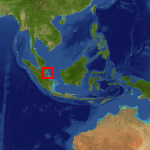 NASA VISIBLE EARTH |
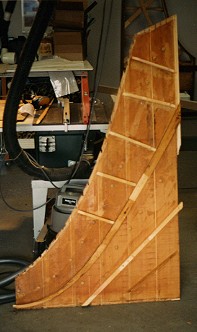
Arrival
at the workshop
The instrument was crated and airfreighted to Sydney in September 1993. Prior
to dismantling, the existing strings were measured, and a rubbing made of the
layout of the instrument. The Michael Thomas English soundboard dating from 1979
was removed in one piece, and the extreme rigidity found to be caused by recently
fitted heavy ribs attached directly to the upper braces, effectively preventing
any soundboard drop but also completely deadening the tone.
It was considered necessary to replace the Michael Thomas soundboard and a decision was made not to sacrifice the end quality by attempting to reuse the old bridges, nuts and rails. A new board with matching wrestplank veneer was prepared using the highest quality twenty-year old Swiss pine, with new bridges, 4´ hitchpin rail, and a more traditional barring arrangement with traverse ribs in the soundboard rose area. A Ruckers-style rose was fitted to allow internal case ventilation because of the solid bellyrail dating from Dolmetsch.
No Dolmetsch internal bracing remained. The recessed bottom was reglued so thoroughly during previous repair that it was judged impossible to remove without destroying it, so all the soundboard and case work was completed from the top. The soundboard support blocks added to the upper braces during a previous repair were removed. The upper bracing was found to be sufficient after the addition of two upper brace glue wedges against the bentside liner of the two treble-most braces. Because of the complete absence of lower bracing, two lower frames were added. The existing gap spacers were retained. The bentside and its liner were reglued in the treble where they showed signs of delamination. The bellyrail capping which had come almost completely unstuck and swung forward, was removed, the red paint cleaned from the gluing surfaces, and strongly reglued to the bellyrail. The new 4´ hitchpin rail was firmly wedged in place at the treble end.
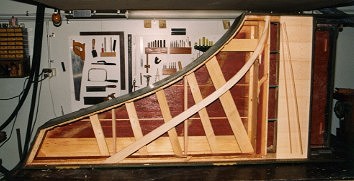 The
wrestplank veneer was removed and the wrestplank found to have been resurfaced
in the 1979 English rebuilding with a 12mm plywood facing. It was decided to
use the existing tuning pin holes after the new veneer to match the new soundboard
was fitted. New nuts were fitted, but the existing buff batten and carved beech
stop levers were reused. Work on the new soundboard was carried out at very
high humidity, and installation took place at 80%, slightly drier than its
expected surroundings in Singapore. A deliberate crown was built into the soundboard
by screw support of the 4´ hitchpin rail and at several points under the 8´ bridge
during the soundboard installation.
The
wrestplank veneer was removed and the wrestplank found to have been resurfaced
in the 1979 English rebuilding with a 12mm plywood facing. It was decided to
use the existing tuning pin holes after the new veneer to match the new soundboard
was fitted. New nuts were fitted, but the existing buff batten and carved beech
stop levers were reused. Work on the new soundboard was carried out at very
high humidity, and installation took place at 80%, slightly drier than its
expected surroundings in Singapore. A deliberate crown was built into the soundboard
by screw support of the 4´ hitchpin rail and at several points under the 8´ bridge
during the soundboard installation.
A single piece bentside hitchpin rail was used with new mouldings around the soundboard perimeter. These parts, often prone to tension failure when poorly glued, and two wrestplank side cleats which were previously just screwed, were glued using the strongest water resistant aliphatic resin glue.
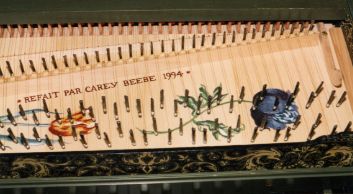 Soundboard
decoration
Soundboard
decorationStringing
The tuning pins were cleaned of their worst corrosion, and each one reused in
their respective hole. The new iron hitchpins were cadmium plated to delay
rusting. It was found that accumulated errors from the various alterations
the instrument had seen over the years resulted in poor string spacing in
several localities, especially in the treble position of the 8´ hitchpins.
These were subsequently remarked, and other gross errors corrected for consistency.
Computer modeling was used to examine the strings from the European alterations,
and determine the best schedule for restringing with historic-type wire. The
original total tension of 1048kg was reduced to 808kg. The iron wire, already
tinned, was rubbed during the stringing process with a light residual anti-corrosion
solution to help further delay corrosion under the extreme humidity conditions
found year-round in Singapore.
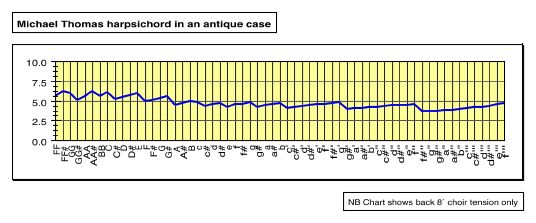
Keyboards
The keyboards dating from 1979 with their various later amendments were reused
after cleaning, polishing, leveling and correcting gross spacing errors. The
original balance punchings showed signs of severe insect attack, so the best
were used for one keyboard and new ones fitted for the other. Modification was
also made to the coupler tracks to help prevent askew movement, but both left
and right coupler tracks are very small and the arrangement still remained somewhat
flimsy. The transposing piece was reduced in thickness to allow sufficient clearance
for correct operation of the transposing mechanism. Two keyboard height adjustment
screws were fitted through the bottom.
Action
New beech registers for the new plastic jacks were made using the existing registers
as models to preserve the non-standard key spacing. Small capstans were used
to assist in ease of adjustment after acclimatization because lack of either
a spine or cheek window would make it impossible to remove the registers in this
instrument when the strings are in place. The original lower guide was split
with the lower keyboard choirs supported from a thick batten screwed to the bottom.
This batten was removed, and the scheme changed to allow a single lower guide,
with all three choirs suspended just below wrestplank level. A new dampchaser
was fitted with its power cord penetrating the front bottom, to replace the previous
dampchaser whose cord was obtrusively routed through the keywell.
The heavy wooden jacks from 1979 were not reused. The instrument was jacked using modern Zuckermann lightweight brown plastic jacks with celcon plectra for the 8´ choirs and thin delrin for the 4´. (Thin celcon was not yet available.) Final voicing and regulation were carried out at A415. The modern red thick jackrail felt was replaced with nailed layers of loose woven hopsacking, and the critical height adjustment made to all three choirs in the jackrail with tapered wooden shims or additional hopsacking strips where necessary. A strip of tapered deer skin was guillotined for the buff stop pads.
Case completion
The case was washed down with antiseptic solution to destroy mould spores. The
areas of the decorative paper damage around the soundboard rim were carefully
painted black to improve appearance, and minor case scrapes were touched green.
A new lid stick, music desk and traveling trestle stand were made, and a custom
made padded cover supplied for the future protection of the harpsichord.
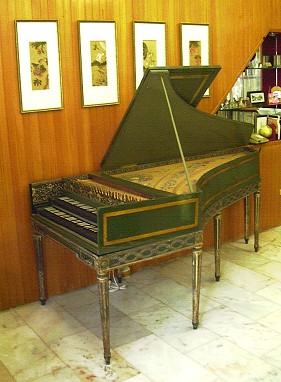
Conclusion
While much of the instrument was not new, there was no evidence found during
the work of either material, design or construction technique to suggest
any part of the harpsichord itself once dated from earlier than Dolmetsch’s
time. Several features of the instrument’s construction point to this
conclusion, including the corner joints, recessed bottom, laminated bentside,
heavy internal liners, single piece bellyrail, signs of the Dolmetsch internal
bracing (removed in past work) and the red painted interior.
Perhaps close examination of the Louis-XVI style stand might reveal that it had indeed survived from the eighteenth-century and Dolmetsch made this instrument to suit. The old 8´ bridge reused by Michael Thomas on his 1979 soundboard was originally single pinned and the second choir subsequently added with a different pin type. This was most likely Dolmetsch’s bridge, but perhaps closer analysis of the bridge pins will reveal more of its history.
All displaced parts were packed for return of the instrument by airfreight to Singapore in early September 1994.
Since then, due to the generosity of the private owner, the instrument has added much to the musical life of Singapore. It has been used by visiting artists including Trevor Pinnock and The English Concert, I Fagiolini and The American Bach Soloists. The harpsichord made a subsequent visit to the workshop in 2002 to correct serious termite damage and continues to sound and play exceptionally well in the adverse tropical climate.| Restoration | |
| Site overview | |
| Harpsichords Australia Home Page |